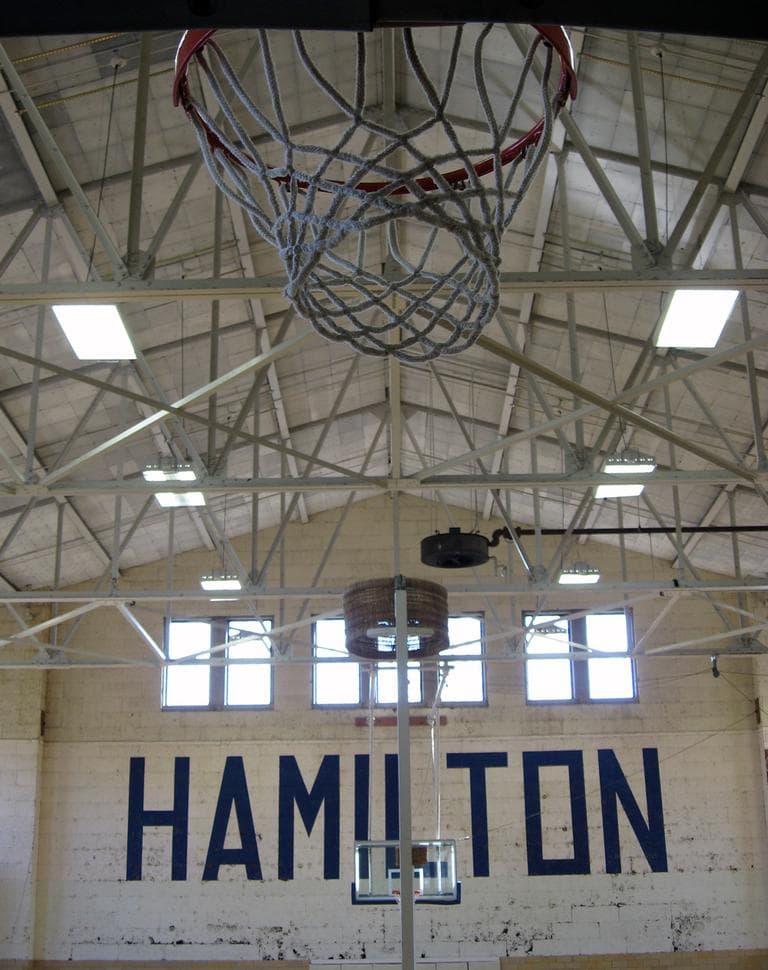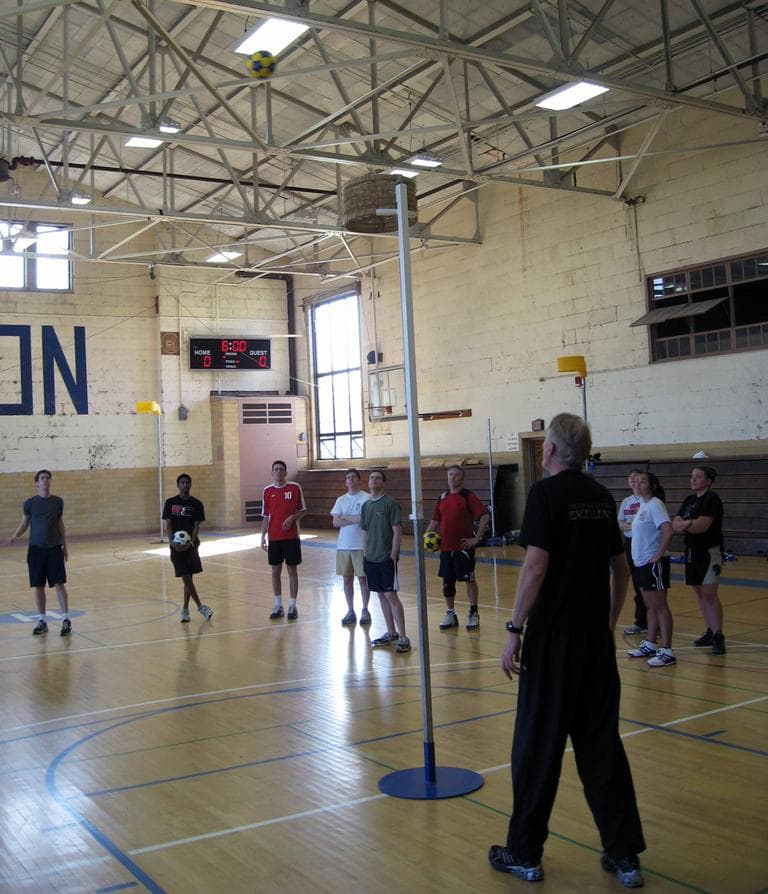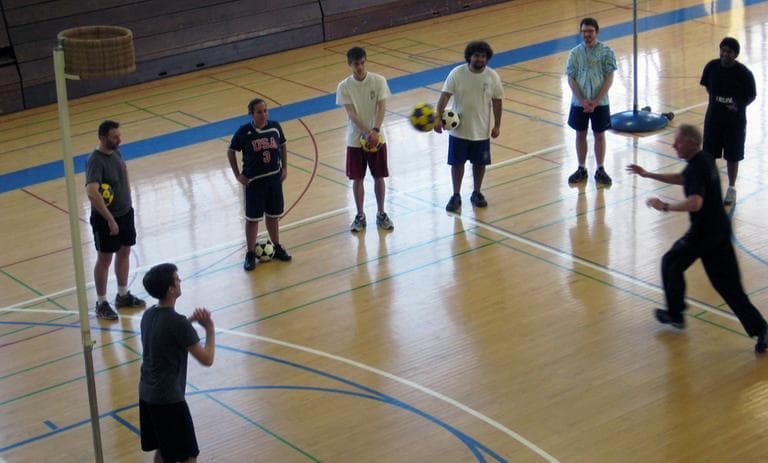Advertisement
Korfball Community Wants You

The word “korf” means “basket” in Dutch, and korfball was created in Holland, so many people refer to it as “Dutch basketball.” But the group of enthusiasts gathered for a tournament at Hamilton College in Clinton, N.Y. will gladly provide a long list of the differences between korfball and American basketball.
I think of basketball with some European or soccer-type rules.A great way to start is to think of it as a cross between ultimate Frisbee and basketball.
It’s co-ed and you move the ball by passing, so it’s a lot of cooperation.
You’re trying to get the ball into this hoop, the korf, taller than a basketball hoop with no backboard, so a little added challenge to it.
Why there’s no backboard? Who knows? That’s just what they had.
When you’ve got the ball you can’t move. You can pivot.
It’s one point per basket, regardless of where it’s shot from.
Two weeks ago, Hamilton College’s korfball organization, Hamilkorf, hosted its second annual tournament. Louis Boguchwal, a junior at Hamilton, is the founder. Originally from Pound Ridge, N.Y., Boguchwal spent his first year of college in St. Andrews, Scotland and tried korfball on a whim.

“I’d never heard of it and my goal on my year abroad was just do everything I can," Boguchwal said. "Get into something cultural I’d never heard of. This really fit the bill, so I joined and it was a great group of people and it was just this interesting sport that anyone can play.”
When Boguchwal decided to transfer to Hamilton for his sophomore year, he wasn’t ready to give up his new hobby.
“I thought, ‘You know there’s one thing, I don’t want to leave behind. And that’d be korfball,'” Boguchwal said. “So I said, ‘I’m going to do whatever it takes to get this going in the U.S. or get it going at Hamilton. At the very least, give it a shot.’”
Boguchwal held an information session and before long, Hamilkorf was holding two practice sessions a week. These days, the korfball pitch is often set up on a well-worn basketball court in an old campus gym. Korfball hoops are 3.5 meters, or about 11-and-a-half feet, high. Older hoops feature a wicker cylinder, like a large laundry basket with the bottom cut out. The cylinders on modern hoops are bright yellow plastic.
Advertisement
At the gym, students warmed up, shooting traditional black and white korfballs, which look exactly like soccer balls, and newer versions, which are gold and blue.
The morning of the tournament opened with an instructional session led by Steve Barker. Today, Barker lives in Los Angeles, but he learned the game in the 1970s as a teenager growing up in England. He went on to play for Great Britain’s national team and has coached at just about every level. He demonstrated the way to follow through on a korfball shot, which is a sort of two-handed set shot.
“Make sure that you’re expressing the shot fully,” Barker called out, putting his arms all the way up, wrists pointing down. “Really extend the fingers into the shot. You’re taking all that power from the body and expressing it in the hands!”
There are 16 players on the korfball court at a time, four women and four men per team. Barker says the game’s structure keeps everyone involved and prevents people from becoming offensive or defensive specialists.
“The court is split into two halves. So, four [members] of the team, two men and two women [on one end], four at the other end,” Barker explained. “One would be defense, one would be attack. Now after two goals they swap over.”
Carl Yerger traveled to New York from North Carolina where he’s a math professor at Davidson College. Yerger learned the game in England while studying at Cambridge. He says because there’s no dribbling and players cannot shoot when they’re closely guarded, korfball hasn’t followed basketball’s evolutionary path.
“Height is less of an advantage in korfball and it’s more about speed and quickness and strategy, and the fact that it’s really hard for one person to take over a game,” Yerger, the United States Korfball Federation board member, said. “You can’t just give the ball to the LeBron of korfball or the Kobe of korfball because they can only take two steps with the ball. It’s not like they juke through their defenders, turn around twice and then dunk it. It just doesn’t work in korfball.”

Karla Wolters is a retired kinesiology professor who taught a korfball course that sparked a brief craze a few years ago at Hope College in Holland, Mich. She says it caught on quickly with her students.
“I have found that they love it being a co-ed game," Wolters said. "They can play with their boyfriend or their girlfriend, play at the same time. You don’t have to cheer from the sidelines, you can play together. It’s something that they really probably haven’t done since elementary school, play a sport together.”
Hamilton student James Kamihachi says he was never an athlete in high school, but he quickly got comfortable playing korfball.
“I liked the lot of the people in korfball, made a lot of good friends here, but for me it was a game that was easy to pick up. It’s a very passing oriented game, so everyone gets to play,” Kamihachi said. “It was a sport that I could actually participate in and I actually got to point where I was reasonably good and felt confident. It was really the first team sport I’ve ever played.”
Kamihachi’s words would probably make korfball creator Nico Broekhuysen smile. Broekhuysen was a schoolteacher in Amsterdam in the early 1900s. After seeing an exhibition of a new sport called basketball in Sweden, Broekhuysen began developing a game all of his students — male and female — could play simultaneously. He unveiled korfball in Holland in 1903.
Today, the International Korfball Federation has member organizations in more than 50 countries. Here in the U.S., the game’s been played for decades. Rockport, Maine resident Rebecca Shields first played in the late 1970s at Oral Roberts University in Tulsa, Oklahoma.
“In the 1970s and the '80s there was some momentum," Shields said. "We were trying to drum up support, getting clubs started. There was one in Tulsa, Okla., in Eugene, Ore., and Houston, [and at] the University of New Mexico, so there were some clubs in different parts of the United States. Then as those people started having families and people got busy then that momentum was starting to kind of crunch.”
That’s why a small korfball event in a tiny upstate New York village attracted players from all over the country. Korfballers have a tough time getting a game.
U.S. Korfball Federation President David Warren, who makes korfball hoops and provided Hamilkorf with its first set of equipment, came all the way from West Virginia.
“I drove up here, it was about 8 hours," Warren said. "And I came to play because it’s the only game in town. We don’t have too many events going on, so if I wanted to play I had to come.”
Warren also learned the game in the 1970s at Oral Roberts University and has played for the U.S. at multiple world championships. He says it’s frustrating to see the sport struggle here after seeing how it’s flourished overseas.

“If you go to a Dutch korfball club, you’ll have korfball players that could be 5 years old or 65 years old," Warren said. "Some clubs might have ten teams, but every level is represented from the highest level to just recreation, kind of like softball is here. You have church teams and you have recreation teams, and you have real competitive teams and that’s the way it is over in Holland.”
After the training session at the tournament ended, scrimmaging began. A true korfball court would be 40 meters by 20 meters, roughly a third larger than a basketball court. Play carries on in front and in back of the hoops, and without a backboard in the way, shots and misses can come from any and all angles around the free-standing post.
Games last 60 minutes and with baskets worth just one point apiece, they’re not high scoring affairs. Elite teams might score between 20 and 30 points in a game. At Hamilton, with a mix of rusty veterans and developing newcomers, most of the final scores end in the single digits.
Can the new burst of enthusiasm at Hamilton launch a korfball comeback? Tournament organizer and USKF board member Louis Boguchwal is trying to get other colleges interested in korfball. He’s not sure if it will spread, but he knows the kind of people the sport needs.
“These people are definitely open-minded," Boguchwal said. "They heard about this and they’re at least willing to show up and give it a go. They’re people who want some exercise, want to have some fun, but they don’t want to be on a team six days a week giving a couple of hours a day. They want to try something new. Also, I guess you might say there’s something kind of crazy, zany about them.”
If that sounds like you, korfball may be your sport. Nearly all of the players in the tournament say making new friends is one of the best parts of the game. It’s a small, close-knit group, but they’d love to add a few more members.
This segment aired on April 23, 2011.
